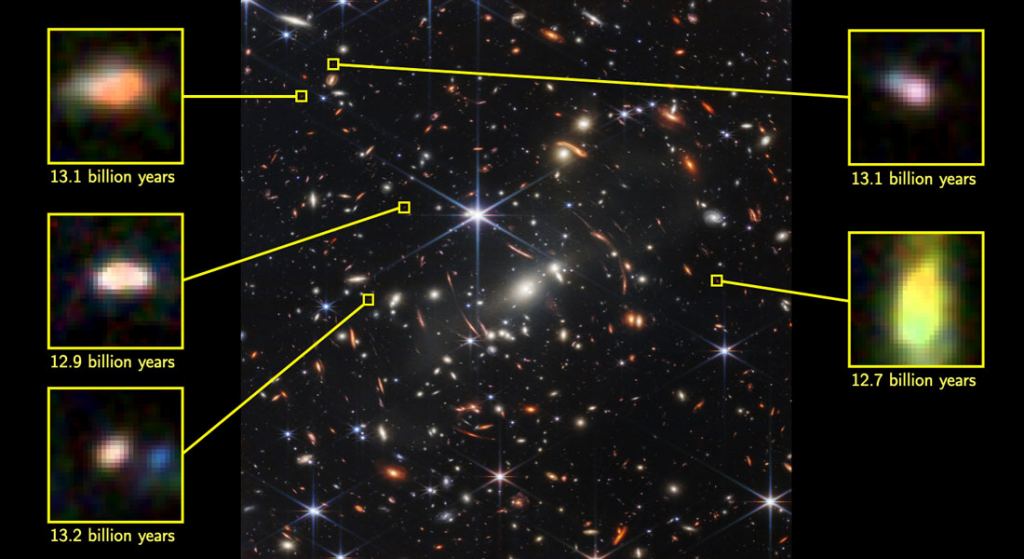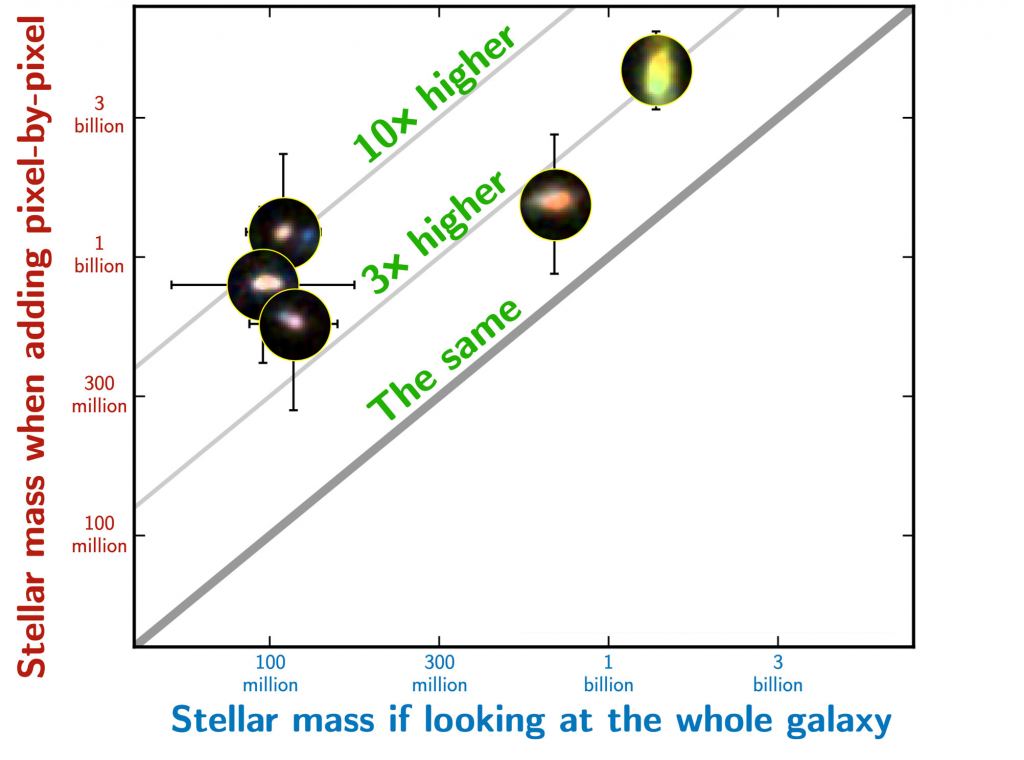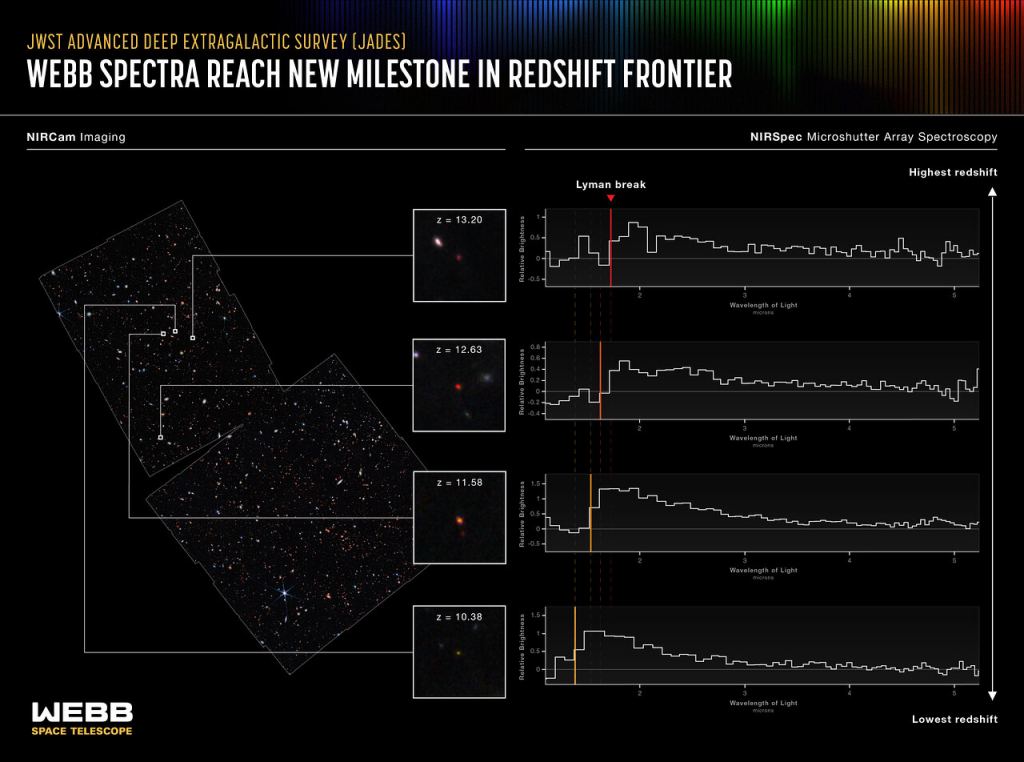The James Webb Space Telescope (JWST) was designed to probe the mysteries of the Universe, not the least of which is what the first galaxies looked like. These galaxies formed during the Epoch of Reionization (aka. “Cosmic Dawn”), which lasted from about 100 to 500 million years after the Big Bang. By observing these galaxies and comparing them to ones that see closer to our own today, astronomers hope to test the laws of physics on the grandest of scales and what role (if any) Dark Matter and Dark Energy have played.
Unfortunately, early into its campaign, the JWST detected galaxies from this period so massive that they were inconsistent with our understanding of how the Universe formed. The most widely-accepted theory for how this all fits together is known as the Lambda Cold Dark Matter (LCDM) cosmological model, which best describes the structure and evolution of the Universe. According to the latest results from the Cosmic Dawn Center, these galaxies may be even more massive than previously thought, further challenging our understanding of the cosmos.
The research team was led by the Cosmic Dawn Center (DAWN) and included researchers from the Niels Bohr Institute (NBI) at the University of Copenhagen, the European Southern Observatory (ESO), the Kavli Institute for Particle Astrophysics and Cosmology (KIPAC) at Stanford University, and astronomers and astrophysicists from the Université de Genève, the University of Texas at Austin, the University of Colorado, and UC Santa Cruz. The paper that describes their findings appeared in the May 10th issue of The Astronomical Journal.

The galaxy cluster SMACS 0723, with the five galaxies selected for closer study. Credit: NASA/ESA/CSA/STScI/Giménez-Arteaga et al. (2023), Peter Laursen (Cosmic Dawn Center).
Among the first images shared by the JWST was the breathtaking view of the SMACS 0723 galaxy cluster known as Webb’s First Deep Field (shown above). This image was acquired by Webb’s Near-Infrared Spectrograph (NIRSpec) and provided a detailed look at how the galaxies in this cluster appeared 4.6 billion years ago. In addition, the image was filled with gravitational lenses that allowed astronomers to get a closer look at more distant objects, including the most distant galaxy ever seen (GL-z13, now known as GLz-12) and several “Green Pea” galaxies dated to the early Universe.
The only problem is that Webb noticed more galaxies than was anticipated in this period, and some were more massive than what was thought possible. According to the LCDM model, there simply wasn’t enough time since the Big Bang for so many galaxies to have formed or become so massive. This led to all kinds of claims, including the notion that the Big Bang model was wrong, a highly-questionable claim made by proponents of the Steady State Hypothesis. While these findings did not throw our entire cosmological understanding into disarray, they nonetheless beggared an explanation.
To clarify Webb‘s earlier observations, a Ph.D. student at the Cosmic Dawn Center (Clara Giménez Arteaga) and colleagues analyzed the data further. In their paper, they describe how they observed five galaxies in the SMACS 0723 Deep Field with redshifts (z) of 5 to 9, which appear to us as they would have roughly 12.7 to 13.2 billion years ago. Based on their analysis, the team hypothesizes that what we’re seeing at work here is an effect that could mean these galaxies are even larger than they appear. As Arteaga explained in an NBI press release:
“We used the standard procedure to calculate stellar masses from the images that James Webb has taken, but on a pixel-by-pixel basis rather than looking at the whole galaxy. In principle, one might expect the results to be the same: Adding the light from all pixels and finding the total stellar mass, versus calculating the mass of each pixel and adding all individual stellar masses. But they’re not.”

The stellar mass of the five galaxies, showing mass inferred using the two different methods. Credit: Giménez-Arteaga et al. (2023), Peter Laursen (Cosmic Dawn Center).
Ordinarily, astronomers calculate the stellar mass of galaxies by measuring the amount of light emitted, then inferring the population necessary for this amount. However, upon viewing the sample of five galaxies closer, Arteaga and her team found that if the galaxies were considered as an entity made up of multiple stellar groupings (instead of one big mass), the picture would change drastically. Based on this alternative method, they found that the inferred stellar masses of these five galaxies would be up to ten times greater.
The team then compared the mass of the five galaxies using the two methods and found that the values were always much higher by analyzing them pixel-for-pixel (instead of the inferred brightness approach). As for why this is the case, Arteaga and her team believe it has to do with the composition of galaxies, which is far from singular:
“Stellar populations are a mixture of small and faint stars on one hand, and bright, massive stars on the other hand. If we just look at the combined light, the bright stars will tend to completely outshine the faint stars, leaving them unnoticed. Our analysis shows that bright, star-forming clumps may dominate the total light, but the bulk of the mass is found in smaller stars.”
Proper resolution is very important for accurately estimating stellar mass, one of the main properties through which astronomers characterize galaxies. While this is relatively easy for galaxies that are relatively close to the Milky Way, it remains a challenge for far more distant ones. While the effect Arteaga and her colleagues emphasized has been noted before, it has only been with galaxies as they appear in later epochs of cosmic history. Thanks to Webb’s superior resolution, this is the first time it has been applied to the most distant galaxies.

An international team of astronomers has used data from the James Webb Space Telescope to report the discovery of the earliest galaxies confirmed to date. Credit: NASA/ESA/CSA/STScI
Unfortunately, even Webb is limited when it comes to observing galaxies that existed around 13 billion years ago when the Universe was barely 1 billion years old. The next step, therefore, will be to look for signatures that correlate to the true mass of these galaxies that do not require high-resolution imaging. As Arteaga summarized:
“Other studies at much later epochs have also found this discrepancy. If we can determine how common and severe the effect is at earlier epochs, and quantify it, we will be closer to inferring robust stellar masses of distant galaxies, which is one of the main current challenges of studying galaxies in the early Universe.”








